April
 |
| Deer on the hillside. |
It's April, and the deer herd is grazing on the moorland grass, with some interesting clouds in the background. These look like lenticular clouds, more of this later. The herd now consists mainly of hinds and their younger offspring, with the stags and younger males mostly going their separate ways for a few months.
 |
| Antlers still present. |
There are however some antlers still present at this time of the year, with the young male in this photo showing a few tines. It is perhaps surprising to still see antlers with the herd at this time of the year - it won't be long until antlers are shed, when new ones begin growing immediately. The stags tend to leave the herd to form groups of males whilst their antlers regrow.
 |
| A hind and calf graze together. |
A hind and one of this years calves now well grown, are grazing together. It is difficult to tell if the mother is pregnant again, but she doesn't look overly rotund from this angle so perhaps not. The calf still has quite a fluffy winter coat, with the hind looking more well groomed in comparison.
 |
| A small group of deer grazing in front of lenticular clouds. |
Here the same mother and calf are walking to re-join a group of deer, and we can see a stack of lenticular clouds in the background. The difference in coats from the hind to calf is still clear even at distance here.
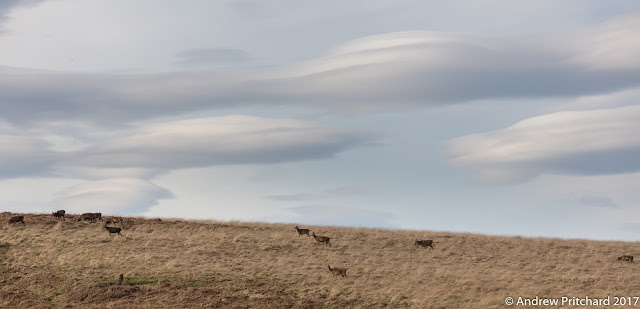 |
| Multiple lenticular clouds above the deer. |
With a wider angled photograph, the lenticular clouds behind the deer are more obvious. The wind direction is coming from mountains to the north west. This is probably causing the standing waves in the air flow, allowing water droplets to condense at the wave crest giving the characteristic lenticular cloud shape.
 |
| Small pointed antlers on a brocket. |
A small pair of small single tine antlers indicate a yearling male or brocket. This one clearly already has the developing shaggy mane of a mature stag, and has very small pointed antlers. In the next years the number of tines in his antlers will increase, and it is likely he will join the separate group of male deer rather than stay with the main herd after the winter.
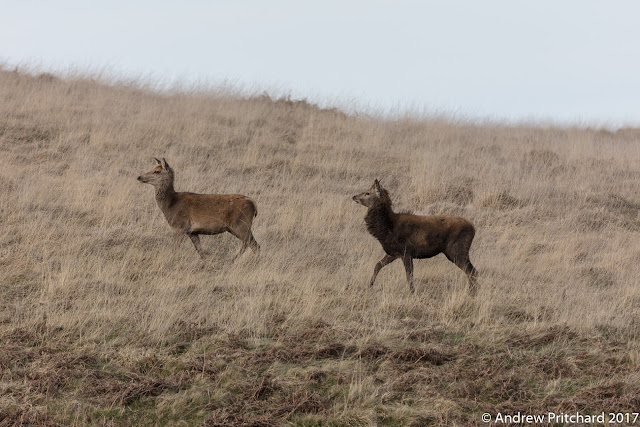 |
| A hind and male brocket walking through yellow grass. |
Another young male brocket, with very small antlers and shaggy mane follows a hind across the moorland. They are probably looking for new grazing, walking through the thick yellow grasses to areas where lusher green grass is growing.
 |
| Two calves showing some legs. |
Over near the lusher green grass, we can see two long-legged calves nibbling grass on the edge of an eroded part of the hillside. It is quite rare to see the full leg of a deer, as they are most often seen walking or standing in the moorland vegetation. The grass on the moor is often a metre or so deep, growing in large clumps, and even the heather will obscure the deer's lower legs.
 |
| The hoof and dew claws of a grazing deer. |
In this close up one of the young deer is nibbling at the exposed grass, which is quite conveniently close to head height for a calf of this size. As the full leg of the animal can be seen the hoof and dew claws are easy to see against the background of eroded hill side.
 |
| A yearling brocket studying a calf. |
Is this sibling rivalry, or is something else going on? The young male brocket seems overly interested in a calf as they are moving to the greener areas. He seems to be having a good look at the youngster, but it is hard to tell quite what is on his mind.
 |
| Just walking away. |
The short nose of the calf may indicate a male, but whatever the cause of the elders interest, the calf walks away from him and although he looks on, nothing more happens. When the males separate into a single sex group their behaviour can be quite boisterous at any time, not just in the rut. Walking with herd towards the more attractive grazing seems more important for the youngster, who probably doesn't notice anything untoward at all.
 |
| A hind looking for new grazing. |
An older hind is walking slowly through the grass, with no urgency, just sedately following the rest of the deer. In comparison to the calf and yearling above, this hind's coat looks a lot smoother. The following images show a probable yearling and calf, both of whom have different shaggier looking coats compared to this hind.
 |
| A shaggier coat. |
Here a younger looking hind, possibly a yearling, squints in the evening sunlight. In contrast to the older hind above, she does seem to have a slightly shaggier coat typical of a younger deer after her first winter. Perhaps younger smaller deer grow a thicker winter coat in relation to body size to help prevent heat loss.
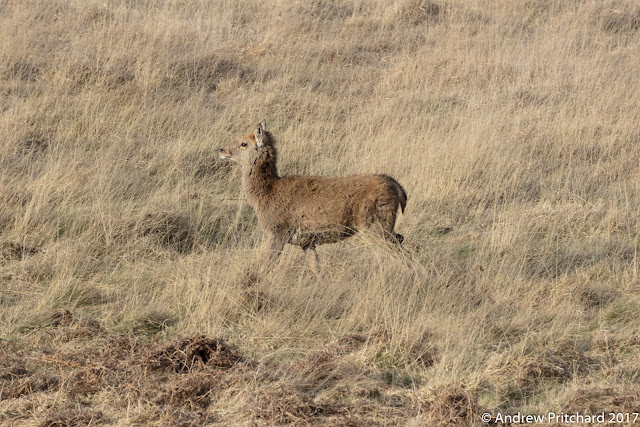 |
| A very shaggy coat! |
A calf walking through the grass, following the herd to new grazing. This calf is even shaggier than the yearling above. This shaggy appearance could be a function of size of deer compared to length of coat, but it does seem that the younger calves and yearlings grow a thicker winter coat than the adults do.
 |
| Three calves and a crow. |
These three calves seem to be interested in the crows gathering nesting material. Perhaps the crows know that the deer will trample the dead grass and bracken, breaking it up into smaller sections for the nest.
 |
| Chasing a crow. |
This calf appears to be chasing off the crow as it walks around looking for bits of grass and bracken. Perhaps the deer recognise the crows as carrion eaters, and may have seen them feeding off the remains of deer who have not survived the moorland winter. It could be the young deer is just being playful.
 |
| Just gathering twigs! |
A crow with it's beak full of nesting material walks away from a young deer, who seems intent on chasing the bird away. Once the bird takes off and flies away the deer will clearly have no chance to pursue it, and indeed would not move to far from the herd anyway.
 |
| Not worth the energy. |
The young deer and two crows face off. Crows are thought to be very intelligent birds, so they are probably quite good at judging where to land near the deer to collect their nesting material. The ability to fly away must also be very useful in this situation.
 |
| Lenticular clouds behind the deer. |
Deer grazing on short green grass with a stack of lenticular in the background. The clouds in this image are some of the nearest to the mountains not visible here. Many of the lenticular clouds shown previously seem to consist of one level, whereas here there are at least two, with possibly a small third forming at the top of the stack.
 |
| An area of flattened or cut grass occupied by grazing deer. |
The deer also seem to like areas of managed grassland where the grass has been cut or flattened. The cutting or flattening of grass on the moorland is probably done for similar reasons as heather burning on grouse moors. It can provide varied habitat for moorland birds such as curlew, lapwings and rarer visitors such as the short eared owl and kestrel.
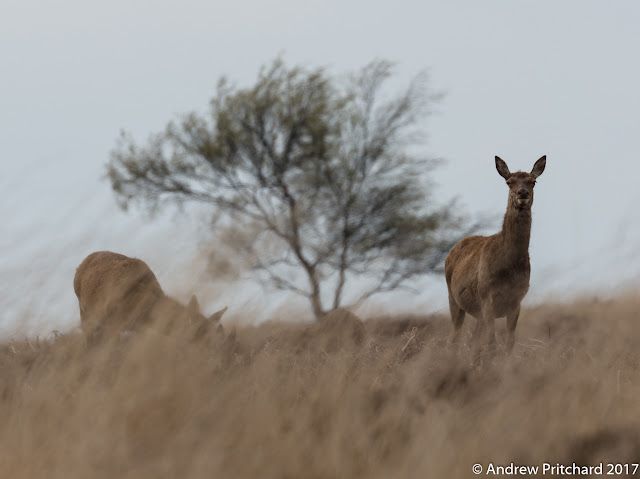 |
| Squinting through the grasses. |
This older looking hind is almost squinting to see what may be hiding in the grass in front of her. The other deer are not showing any interest, but she may be a wise old hind, perhaps being more wary and noticing anything slightly out of the ordinary.
 |
| Having a good look. |
Now with her eyes wide open, she is still unsure, but the other hinds with her are also still none the wiser. They are looking across the moor in a different direction, to where the rest of the deer herd have just walked.
 |
| Three hinds looking right, or nibbling at some irritant. |
Here three hinds are posing nicely, all were looking to their rights as people were walking some distance away. One however seems to have an itch! Perhaps it is her winter coat moulting. Deer can be irritated by their winter coats moulting, and will sometimes use trees to rub against in response to the itching.
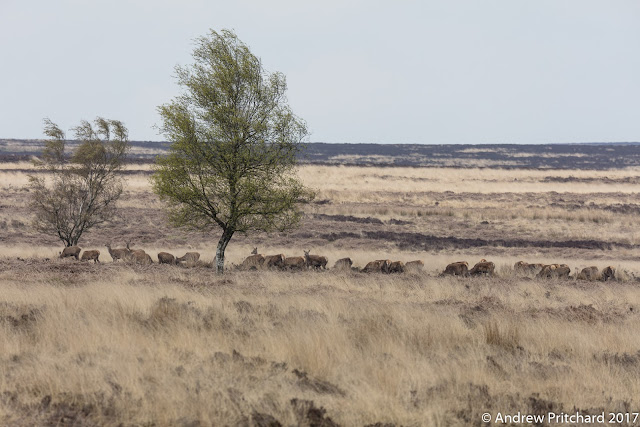 |
| Moorland and trees are a favourite. |
The deer seem happy to live on the moor, but always seem to find a tree or two to gather under, perhaps desiring to be near a scratching post! Most of the trees on the moorland are small, like these silver birch primary colonisers. Nearby is an area of woodland, which has other attractions to pregnant hinds. In a month or two they will begin to separate from the main herd to find places to give birth. Look out for new arrivals in the coming months!
If you would like to see more of the monthly posts from this blog, please subscribe using one of the buttons or links available. You can share this blog using the available buttons. Each blog post will comprise a selection of pictures taken by the author, reflecting red deer activity for the month with some explanatory text.
Comments
Post a Comment